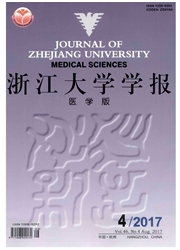

 中文摘要:
中文摘要:
目的:观察内环境因素(pH和甘氨酸及离子浓度)对依达拉奉抗神经元缺血性损伤作用的影响。方法:大鼠原代培养皮质神经元,在不同的实验溶液(模拟缺血后脑内环境的变化)以缺氧缺糖(oxygen-glucosed eprivation,OGD)3h和再灌12h诱导皮质神经元损伤,以噻唑蓝(MTT)还原反应和乳酸脱氢酶(LDH)释放观察损伤变化。观察不同实验溶液对抗脑缺血药物依达拉奉抗缺血性损伤作用的影响。结果:在弱碱性(pH7.8)或含甘氨酸(10μmol/L)的实验溶液中,OGD损伤加重;在弱酸性(pH6.5)或高Mg^2+(1.8mmol/L)条件下,OGD损伤减轻。依达拉奉(1μmol/L)能逆转在pH6.1、7.4、7.8或含甘氨酸溶液中OGD损伤;而对pH6.5、高Mg^2+或低Ca^2+溶液中的OGD损伤未显示保护作用。结论:内环境因素改变可影响缺血性损伤程度和依达拉奉抗损伤作用。
 英文摘要:
英文摘要:
Objective. To determine whether homeostatic conditions (pH, glycine or ion concentration) affect the protective effects of edaravone on ischemic injury in rat cortical neurons. Methods: In cultured rat cortical neurons, the compositions in the experimental solutions were changed to mimic the disturbance of homeostasis after cerebral ischemia. In vitro ischemic injury was induced by oxygen-glucose deprivation (OGD) for 3 h and reperfusion for 12 h, and the neuron injury was evaluated by 3-(4,5-dimethylthiazol-2yl)-2,5-diphenyl tetrazolium bromide (MTT) reduction assay and lactate dehydrogenase (LDH) release. Effect of edaravone on OGD injury was observed in different experimental solutions. Results: In weak alkalified solution (pH 7.8) or the solution containing glycine (10 μmol/L), OGD injury became more serious; but in weak acidic (pH 6.5) or higher Mg^2+ (1.8 mmol/L) solutions, OGD injury was attenuated. Edaravone (1 μmol/L) reversed the injury in the solutions with pH 6.1, 7.4 and 7.8 or the solution containing glycine, but did not show protective effect in the solution with pH 6.5 and the higher Mg^2+ or lower Ca^2+ solution. Conclusion: The changes of homeostatic conditions affect the severity of ischemic injury of neurons and the protective effect of edaravone.
 同期刊论文项目
同期刊论文项目
 同项目期刊论文
同项目期刊论文
 期刊信息
期刊信息
